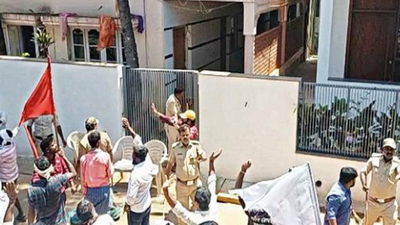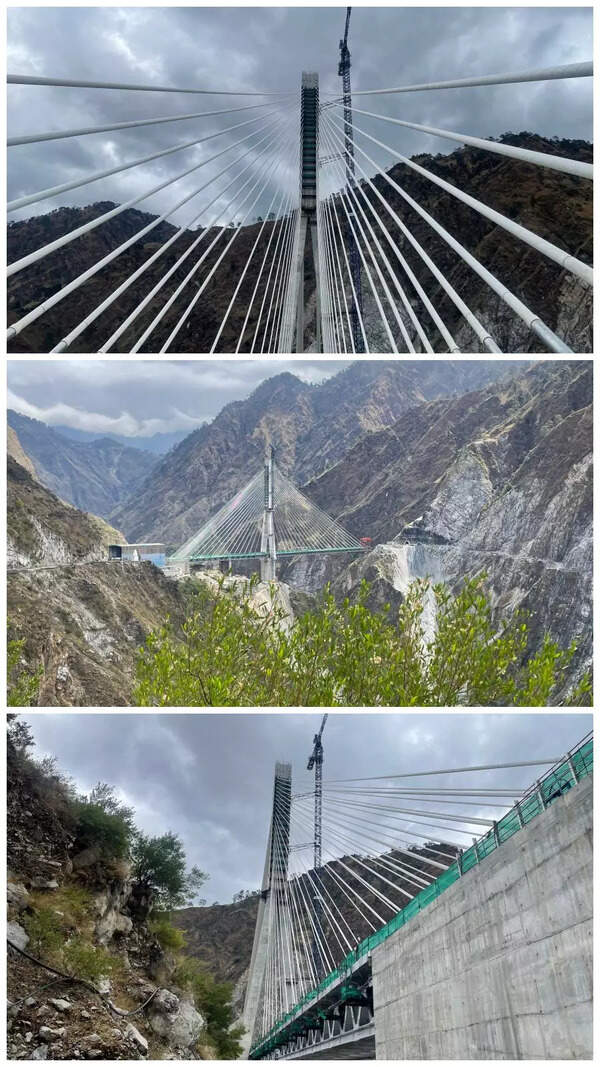- News
- City News
- bengaluru News
- Karnataka elections 2023 news | Internal reservation: Banjaras throw a spanner in BJP's arithmetic of gains
Trending Topics
Karnataka elections 2023 news | Internal reservation: Banjaras throw a spanner in BJP's arithmetic of gains

Banjaras recently staged a protest outside former chief minister BS Yediyurappa’s house in Shikaripura
BENGALURU: The state cabinet recently recommended to the Centre the implementation of the internal reservation or reclassification of the 17% reservation for schedule castes amongst sub-sects of Dalits, months after hiking their reservation by 2%. The BJP is hoping these two moves will help it reap rich dividends in the upcoming assembly polls.
However, the picture still doesn't look too rosy for them as a section of Dalit sub-castes, including Lambani (Banjara), Bhovi, Koracha and Korama, who were considered BJP supporters, are sulking and strongly opposing the move. Interestingly, these four communities have been protesting despite getting higher quotas than what was recommended in the Justice Sadashiva Commission Report, which went into the issue of internal reservation.
"Without internal reservation, we were enjoying a quota as much as 10%, but now our quota has been restricted to a meagre 4.5%,'' said an aggrieved senior BJP MLA representing the Lambani community.
To understand the community's plaints, the Justice Sadashiva Commission report is vital. The commission was set up in 2005 by the JD(S)-Congress government to review distribution of reservation benefits among SC and ST groups. After a survey involving about 96 lakh SC members, it stated in its report submitted to then CM DV Sadananda Gowda in 2012 that the benefits of reservation and of welfare schemes in Karnataka were reaching only a few groups among SCs and STs and that several other sub-sects were the worst affected as a result.
Therefore, it recommended providing internal reservation by broadly classifying the 101 sub-sects of SCs in the state into four categories - left wing, right wing, other SCs, and touchables. Based on the then 15% reservation for SCs, it recommended 6% for the left wing, 5% for the right, 1% for other SCs, and 3% for touchables to ensure that the benefits of welfare programmes reached all the needy.
Though the BJP government did not use the Sadhashiva Commission report as its basis for providing internal reservation, the state cabinet recently recommended a 6% internal quota for SC (left), 5.5% for SC (right), 4.5% for touchables (Banjara, Bhovi, Korcha, Kuruma, etc.,) and 1% for others under the current reservation of 17%.
Opposition leaders argue that these recommendations stemmed from political calculation, as the SC (right) is regarded as traditional Congress supporters and the SC (left) BJP supporters, but the last-minute decision has backfired as touchables, who supported BJP in previous polls, have turned against them.
This despite there being no clarity on whether the state government is empowered to provide for internal reservation. According to some constitutional experts, under Article 341(1), the list of scheduled castes eligible for reservation is to be prepared by the state and then notified by the President of India. The removal or the inclusion of any caste or part or group of such caste from the list shall be done by parliament through a law, according to Article 341 (2). However, the Constitution is silent on the internal sub-classification of any existing scheduled caste reservation.
"There are only two ways to implement it. The Union government should initiate the process of a constitutional amendment to insert clause 341 (3), which will allow the reclassification of the scheduled caste reservation and enable state legislatures to enact the same, or the Supreme Court should constitute a seven-judge bench to expedite a pending case. Or else, no state legislature, including Karnataka, has the legislative competence to implement sub-classifications in the SC reservation list,'' said senior advocate N Venkatesh.
However, Union minister of social justice A Narayanaswamy said a Supreme Court judgement in 2020 provides enough room from the state government to implement internal reservation.
However, the picture still doesn't look too rosy for them as a section of Dalit sub-castes, including Lambani (Banjara), Bhovi, Koracha and Korama, who were considered BJP supporters, are sulking and strongly opposing the move. Interestingly, these four communities have been protesting despite getting higher quotas than what was recommended in the Justice Sadashiva Commission Report, which went into the issue of internal reservation.
"Without internal reservation, we were enjoying a quota as much as 10%, but now our quota has been restricted to a meagre 4.5%,'' said an aggrieved senior BJP MLA representing the Lambani community.
To understand the community's plaints, the Justice Sadashiva Commission report is vital. The commission was set up in 2005 by the JD(S)-Congress government to review distribution of reservation benefits among SC and ST groups. After a survey involving about 96 lakh SC members, it stated in its report submitted to then CM DV Sadananda Gowda in 2012 that the benefits of reservation and of welfare schemes in Karnataka were reaching only a few groups among SCs and STs and that several other sub-sects were the worst affected as a result.
Therefore, it recommended providing internal reservation by broadly classifying the 101 sub-sects of SCs in the state into four categories - left wing, right wing, other SCs, and touchables. Based on the then 15% reservation for SCs, it recommended 6% for the left wing, 5% for the right, 1% for other SCs, and 3% for touchables to ensure that the benefits of welfare programmes reached all the needy.
Though the BJP government did not use the Sadhashiva Commission report as its basis for providing internal reservation, the state cabinet recently recommended a 6% internal quota for SC (left), 5.5% for SC (right), 4.5% for touchables (Banjara, Bhovi, Korcha, Kuruma, etc.,) and 1% for others under the current reservation of 17%.
Opposition leaders argue that these recommendations stemmed from political calculation, as the SC (right) is regarded as traditional Congress supporters and the SC (left) BJP supporters, but the last-minute decision has backfired as touchables, who supported BJP in previous polls, have turned against them.
This despite there being no clarity on whether the state government is empowered to provide for internal reservation. According to some constitutional experts, under Article 341(1), the list of scheduled castes eligible for reservation is to be prepared by the state and then notified by the President of India. The removal or the inclusion of any caste or part or group of such caste from the list shall be done by parliament through a law, according to Article 341 (2). However, the Constitution is silent on the internal sub-classification of any existing scheduled caste reservation.
"There are only two ways to implement it. The Union government should initiate the process of a constitutional amendment to insert clause 341 (3), which will allow the reclassification of the scheduled caste reservation and enable state legislatures to enact the same, or the Supreme Court should constitute a seven-judge bench to expedite a pending case. Or else, no state legislature, including Karnataka, has the legislative competence to implement sub-classifications in the SC reservation list,'' said senior advocate N Venkatesh.
However, Union minister of social justice A Narayanaswamy said a Supreme Court judgement in 2020 provides enough room from the state government to implement internal reservation.
Start a Conversation
FOLLOW US ON SOCIAL MEDIA
FacebookTwitterInstagramKOO APPYOUTUBE










